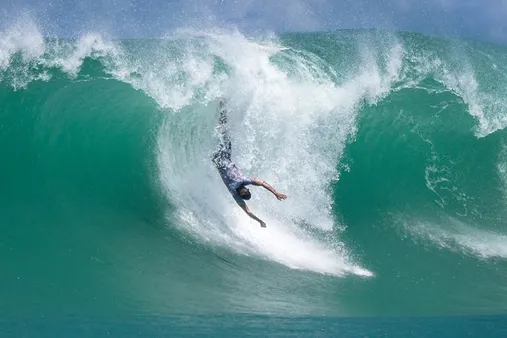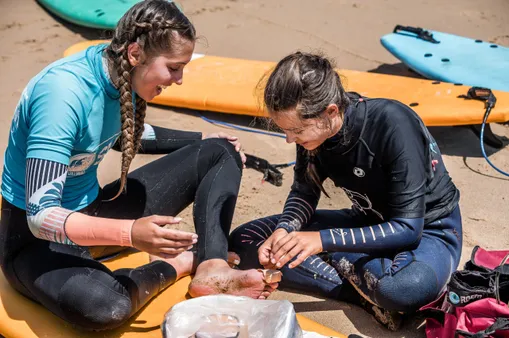Table of Contents
Surfing, a thrilling water sport adored by many, carries an inherent risk of injuries. Kizworld presents a comprehensive guide to "The most common surfing injuries and how to avoid them." Dive into this detailed article to understand the frequency and types of injuries, uncover potential dangers and safety measures, learn about preparation and technique, explore the mental aspect's influence on performance, discover first aid tips, and navigate rehabilitation and recovery processes. Embrace these guidelines to minimize injury risk, enhance surfing capabilities, and ensure a safer and more enjoyable surfing experience.
The Most Common Surfing Injuries and How to Avoid Them
I. Surfing Injuries: Prevention and Treatment
Surfing Injuries: Prevention and Treatment
Surfing, an exhilarating water sport, carries an inherent risk of injuries. This section delves into the common surfing injuries, their prevention strategies, and effective treatment options. By embracing these guidelines, surfers can minimize their risk of injury, enhancing their surfing capabilities and ensuring a safer and more enjoyable experience.
Prevention is key in minimizing surfing injuries. Proper warm-up exercises, such as dynamic stretches and light cardio, can help prepare the body for the physical demands of surfing. Wearing appropriate protective gear, including a helmet, wetsuit, and leash, can also reduce the risk of severe injuries in case of a fall or collision.
- Common Surfing Injuries:
- Cuts and lacerations
- Bruises and contusions
- Sprains and strains
- Dislocations
- Fractures
Surfers should be aware of the potential dangers associated with surfing and take necessary precautions to minimize the risk of injury. This includes being aware of the surf conditions, choosing a suitable break for their skill level, and avoiding surfing in hazardous conditions.
In the unfortunate event of an injury, prompt and appropriate treatment is crucial. First aid measures, such as applying pressure to stop bleeding, immobilizing the injured area, and elevating it, can help minimize further damage. Seeking professional medical attention as soon as possible is essential for proper diagnosis and treatment.
Rehabilitation and recovery play a vital role in regaining surfing strength and preventing future injuries. This may involve physical therapy, massage therapy, and specific exercises to strengthen the injured area and restore range of motion. Patience and adherence to the rehabilitation program are key to a successful recovery.
Surfing injuries can be prevented and treated effectively with proper precautions and prompt medical attention. By embracing these guidelines, surfers can enhance their surfing abilities and reduce the risk of injury, ensuring a safer and more enjoyable surfing experience.
Tip | Description |
Warm up properly | Perform dynamic stretches and light cardio before surfing to prepare your body for the physical demands of the sport. |
Wear protective gear | Wear a helmet, wetsuit, and leash to reduce the risk of severe injuries in case of a fall or collision. |
Choose a suitable break | Select a break that is appropriate for your skill level and experience. Avoid surfing in hazardous conditions. |
Be aware of the surf conditions | Check the surf report and observe the waves before entering the water. Be aware of potential hazards such as rocks, reefs, and strong currents. |
Stay hydrated | Drink plenty of water before, during, and after surfing to stay hydrated and prevent fatigue. |
Surfing is a rewarding and enjoyable sport, but it also carries some inherent risks. By following these prevention and treatment guidelines, surfers can minimize their risk of injury and ensure a safer and more enjoyable surfing experience.
If you are interested in learning more about surfing injuries and how to prevent them, check out our article on The Most Common Surfing Injuries and How to Avoid Them.
II. Common Surfing Injuries
Common Surfing Injuries
Surfing, an exhilarating water sport, carries an inherent risk of injuries. Common surfing injuries include:
- Cuts and lacerations from coral reefs, rocks, or other sharp objects.
- Bruises and contusions from collisions with the board or other surfers.
- Sprains and strains from overexertion or improper technique.
- Dislocations from falls or collisions.
- Fractures from high-impact falls or collisions.
The severity of these injuries can range from minor to life-threatening. It is important to be aware of the risks and take steps to prevent them.
Here are some tips to help prevent surfing injuries:
- Wear a helmet and other protective gear, such as a wetsuit and booties.
- Learn proper surfing technique from a qualified instructor.
- Be aware of your surroundings and other surfers.
- Stay within your limits and don't surf in conditions that are beyond your skill level.
- Warm up before surfing and cool down afterwards.
If you do get injured while surfing, it is important to seek medical attention immediately. Early treatment can help to prevent serious complications.
Surfing is a great way to get exercise and enjoy the ocean. By taking steps to prevent injuries, you can help to ensure that you have a safe and enjoyable experience.
Related posts:
- The Benefits of Surfing for Fitness and Fun
- How to Choose the Right Surfboard for Your Skill Level and Style
- The Best Surfing Equipment and Accessories
III. Avoiding Surfing Injuries
Avoiding Surfing Injuries
While surfing is a thrilling water sport, it carries an inherent risk of injuries. By following a few simple precautions, surfers can greatly reduce their chances of experiencing an injury.
One of the most important things surfers can do to avoid injuries is to wear the proper safety gear. This includes a helmet, a leash, and a wetsuit. A helmet can protect your head in the event of a fall, while a leash will keep your board from getting away from you if you wipe out. A wetsuit can help keep you warm and protected from the sun and waves.
- Wear a helmet to protect your head in the event of a fall.
- Use a leash to keep your board from getting away from you if you wipe out.
- Wear a wetsuit to keep you warm and protected from the sun and waves.
Another important way to avoid surfing injuries is to be aware of your surroundings and conditions. This means checking the weather forecast and tide charts before you go surfing. It also means being aware of other surfers, obstacles, and marine life in the water.
Surfers should also be properly trained before they go surfing. This means learning the basics of surfing, such as how to paddle, pop up, and ride a wave. It also means learning how to stay safe in the water.
Finally, surfers should listen to their bodies and know their limits. If you are feeling tired, cold, or in pain, it is time to get out of the water. Pushing yourself too hard can lead to injuries.
Equipment | Conditions | Training | Body Awareness |
Wear a helmet, leash, and wetsuit | Check the weather forecast and tide charts | Learn the basics of surfing | Listen to your body and know your limits |
Be aware of your surroundings | Be aware of other surfers, obstacles, and marine life | Practice regularly to improve your skills | Warm up properly before surfing |
Surf in areas that are appropriate for your skill level | Stretch and cool down after surfing |
By following these tips, surfers can help to stay safe and injury-free while enjoying their time in the water.
If you are interested in learning more about surfing, you can find a wealth of information on our website, Kizworld.
IV. Treating Surfing Injuries
Treating Surfing Injuries
Applying Proper First Aid Techniques
- Assess the injury.
- Protect the neck.
- Apply pressure.
- Elevate the injury.
- Immobilize the injured area.
By responding quickly and calmly, you can help minimize the severity of the injury and promote faster healing.
Seeking Professional Medical Attention
- Seek medical attention immediately.
- Explain the injury to the medical professional.
- Follow the doctor's instructions.
If the injury is severe, seeking immediate medical attention is crucial. A doctor can properly diagnose the injury, determine the best course of treatment, and provide pain relief.
Common Surfing Injuries | First Aid Treatment |
|---|---|
Cuts and lacerations | Apply pressure to stop bleeding, clean the wound, and apply a bandage. |
Bruises | Apply ice to reduce swelling and pain. |
Sprains and strains | Elevate the injured area, apply cold compress, and use a compression bandage. |
Broken bones | Immobilize the injured area, apply a splint, and seek medical attention immediately. |
Concussions | Seek medical attention immediately. |
Remember, first aid is only a temporary measure. It is essential to seek medical attention for any serious injuries to ensure proper diagnosis and treatment.
Preventing Surfing Injuries
While injuries in surfing can happen, there are steps you can take to minimize the risk:
- Wear protective gear.
- Warm up properly.
- Start slowly.
- Be aware of your surroundings.
- Learn proper surfing techniques and practice them regularly.
Additionally, regular exercise and maintaining good overall fitness can also help reduce your risk of injury.
Conclusion
Surfing is an exhilarating sport, but it also carries the risk of injuries. By being prepared and taking the necessary precautions, you can minimize the chances of getting injured while enjoying the waves.
If you experience any injuries while surfing, it is crucial to seek medical attention and follow the doctor's instructions for treatment and recovery. Remember, prevention is always better than cure, so focus on practicing safe surfing techniques and staying fit to keep surfing safely and confidently.
Check out our related posts on how to choose the right surfboard, the benefits of surfing, and the best surfing equipment to enhance your surfing experience.
V. Conclusion
Surfing, while exhilarating, carries a risk of injuries that can be prevented with proper knowledge and techniques. Following the guidelines outlined in this article can help surfers minimize their risk of injury, enhancing their surfing abilities and ensuring a safer and more enjoyable experience. Embracing preparation, practicing proper technique, maintaining mental fortitude, and implementing effective first aid and recovery strategies can significantly reduce the likelihood of surfing injuries. By prioritizing safety and adopting these strategies, surfers can maximize their enjoyment of this thrilling sport while mitigating the associated risks.